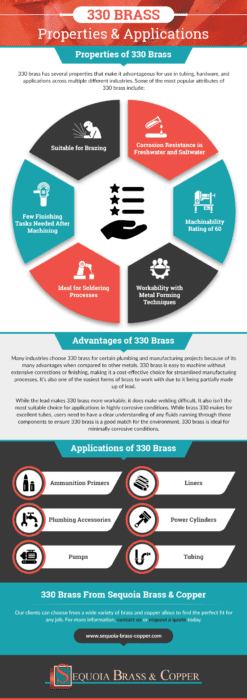At Sequoia Brass & Copper, we supply bars, plates, and sheets of nonferrous metals. For over 25 years, our company has been a leading supplier of nonferrous metals, such as brass and copper, to metal fabrication centers across the United States.
330 brass, or C33000 brass, is a brass material with a low lead content that responds well to machining, forming, and cold working. Sequoia Brass & Copper provides 330 brass for a variety of applications, including commercial and consumer tubing.
Properties of 330 Brass
330 brass has several properties that make it advantageous for use in tubing, hardware, and applications
across multiple different industries. Some of the most popular attributes of 330 brass include:
- Corrosion Resistance. 330 brass won’t rust or degrade due to contact with water, making it an excellent choice for complex tubing and exterior applications. 330 brass can resist corrosion from both freshwater and saltwater.
- Machinability. 330 brass has a machinability rating of 60. The metal is easy to cut, can be used to fabricate complex and precise designs, and has an acceptable surface finish along cut lines.
- Workability. Another characteristic that makes 330 brass a superior choice for fabricating tubes and other products is its workability. The material can be formed through appropriate metal forming techniques and hold the new shape without compromising its structural integrity or other characteristics. It also has good resistance to fracturing and cracking.
- Solderability. 330 brass is an ideal material for soldering processes. Technicians can easily solder joints to brass tubing, provided they account for 330 brass’s high conductivity and oxidation rate.
- Finishing Characteristics. 330 brass has a nice surface finish after cutting and machining processes, meaning there are relatively few finishing tasks required to turn a machined workpiece into a finished product. For example, cut brass elements do not need to be deburred. 330 brass metal can also easily be polished.
- Brazing Characteristics. 330 brass is suitable for brazing to join together metal pieces.
Advantages of 330 Brass
Many industries choose 330 brass for certain plumbing and manufacturing projects because of its many advantages when compared to other metals. 330 brass is easy to machine without extensive corrections or finishing, making it a cost-effective choice for streamlined manufacturing processes. It’s also one of the easiest forms of brass to work with due to it being partially made up of lead.
While the lead makes 330 brass more workable, it does make welding difficult. It also isn’t the most suitable choice for applications in highly corrosive conditions. While brass 330 makes for excellent tubes, users need to have a clear understanding of any fluids running through those components to ensure 330 brass is a good match for the environment. 330 brass is ideal for minimally corrosive conditions.
Applications of 330 Brass
Some of the most common applications for 330 brass include the following:
- Ammunition primers
- Liners
- Plumbing accessories
- Power cylinders
- Pumps
- Tubing
330 Brass From Sequoia Brass & Copper
330 brass is a popular non-ferrous metal alloy for manufacturing and parts production. The material is cost-effective, easy to machine and work, and requires very little finishing. At Sequoia Brass & Copper, we offer high-quality 330 brass for tubing, industrial parts, and more with reliable performance and excellent finished products. Our clients can choose from a wide variety of brass and copper alloys to find the perfect fit for any job. For more information, contact us or request a quote today.

